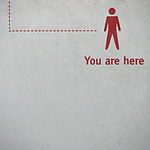It’s been a long, long while since I posted to this blog. For those who were annoyed by that, apologies. For those who didn’t notice, hello. Truth is, I’ve been doing other things. Taking deep dives into areas I didn’t understand as I’d like to (since I teach them, after all), or into aspects of the arts management world that I misunderstood. While it seems likely that I’ll continue those other things, I’d like to do this too.
Here’s the wonder and the challenge of it: Since I started blogging in July 2003 — holy criminy, that’s a dozen years ago — the online discourse on arts, business, policy, and professional practice has grown rich and wonderful. Blogs were new and conversation was pretty sparse, back then. And blogging felt like exploring an open wilderness. So, the explorer didn’t need much of a purpose. The wandering was enough: noticing things along the path, and writing about them.
I’ll admit that after a dozen years of noticing, the path was feeling rote and familiar. Every issue and argument looked more like a well-worn archetype, or a mechanical pattern, than a fresh invention with its own voice and volition. I suppose I discovered that I didn’t just want to notice things, but rather I wanted to know them.
Which led me, as usual, back to Jeanette Winterson’s glorious first essay in her book Art [Objects]: Essays on Ecstasy and Effrontery, where she writes about the trap of experiencing art as if it’s familiar:
Art, all art, not just painting, is a foreign city, and we deceive ourselves when we think it familiar. No-one is surprised to find that a foreign city follows its own customs and speaks its own language. Only a boor would ignore both and blame his defaulting on the place. Every day this happens to the artist and the art.
We have to recognize that art, all art, is not our mother-tongue.
Winterson suggests that a disconnect, disdain, or disinterest in expressive works is more about the observer than the observed. And if you don’t see something interesting, it’s often because you’re not looking long enough, or you’re busy defending what you believe you know in the face of something different.
When you say ‘This work has nothing to do with me’. When you say ‘This work is boring/pointless/silly/obscure/élitist etc.’, you might be right, because you are looking at a fad, or you might be wrong because the work falls so outside of the safety of your own experience that in order to keep your own world intact, you must deny the other world of the painting. This denial of imaginative experience happens at a deeper level than our affirmation of our daily world. Every day, in countless ways, you and I convince ourselves about ourselves. True art, when it happens to us, challenges the ‘I’ that we are.
So, I’ve been looking longer, and deeper, and working hard not to snap to established assumptions or pattern recognitions. And that’s been rather difficult to blog about. But I’d like to try. As Winterson argues, art is about the making rather than the made, the struggle rather than the solution. And maybe the management of cultural enterprise can be more about that too.
The true artist is connected. The true artist studies the past, not as a copyist or a pasticheur will study the past, those people are interested only in the final product, the art object, signed sealed and delivered to a public drugged on reproduction. The true artist is interested in the art object as an art process, the thing in being, the being of the thing, the struggle, the excitement, the energy, that have found expression in a particular way. The true artist is after the problem. The false artist wants it solved (by somebody else).
Which brings me back to a phrase from one of my first paragraphs written for this blog, adapted from television revolutionary Moses Znaimer: “What if, in the end, the arts organization is not a problem to be managed, but an instrument to be played?”
What if? Let’s explore.



Welcome back
Well said!
Nice to see you back!
Andrew thanks for this! It has been my contention for some time that as arts workers we have searched everywhere BUT the practice of art-making for solutions. Meanwhile, businesses are making (generally) lame attempts (innovation strategies, team building, collaborative decision-making, etc.) to adopt creative/artistic strategies to their work. While we have much to learn from other fields for sure, taking a good look at art and the creative process – and making our organizations an artistic practice – would serve us well. I look forward to further commentary from you about this!
Thanks Ken! I love the phrase ‘making our organizations an artistic practice,’ as that’s exactly what I’m striving toward. That art-making is BOTH about being open to the world, and also taking decisive action in the moment.